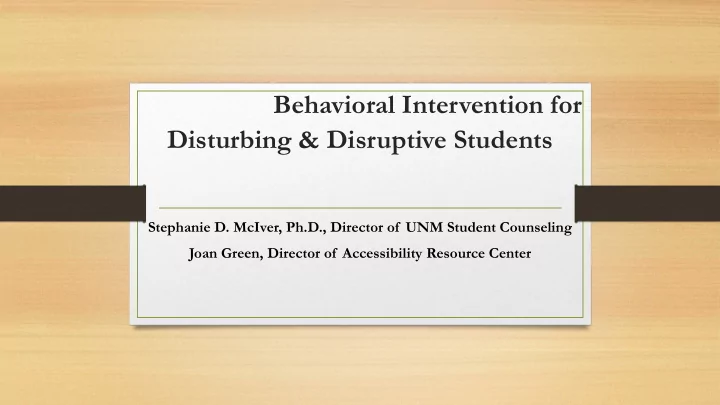

Behavioral Intervention for Disturbing & Disruptive Students Stephanie D. McIver, Ph.D., Director of UNM Student Counseling Joan Green, Director of Accessibility Resource Center
Goals • Define Disruptive and Disturbing Student behaviors • Discuss the obligation to deal with the behaviors • Offer suggestions about handling various types of behavior • Share examples from the audience about “real life” situations
Why is Addressing and Identifying these Behaviors Important? Being proactive, helps UNM to: • Provide resources for students in need so they can continue on academically • Provide a good learning environment for students impacted by another student’s behavior • Provide a safe environment for the UNM Community UNM (think of some of the things that have occurred at the national even international level)
What is Disruptive Behavior? Behavior that interferes with the educational process of other students OR Behavior that prevents faculty or staff from performing their professional responsibilities
Examples of Disruptive Behavior • Making remarks out of turn • Dominating Classroom Lectures • Inappropriate E-mailing to Faculty and/or Staff • Using Cell Phones or other electronic means in the class • Inappropriate use of community list-serve’s or classroom chat functions
What is Disturbing Behavior? Behavior that indicates that the student is in distress. • Whether or not caused in part by his/her school situation, academic performance often will suffer.
Examples of Disturbing Behavior Disturbing behavior can be mild, such as: • Expressing feelings of helplessness or hopelessness • Complaining of Sleeping or Eating Problems Disturbing behavior can also be severe, which includes: - Written references to suicide - Suspected drug or alcohol use - Written or verbal references to paranoia (My professor is trying to poison me at home, a parasite has taken over my body, I was there when President Lincoln gave his famous speech)
Dealing with Disruptive and Disturbing Behavior • If the situation warrants, call campus police at 505-277-2241 (Explain) • Ask the person to stop the behavior if overly distracting to you or class • Ask the person to leave your classroom • If behavior is mildly distracting, talk to the student privately, with another co-worker as a witness or at least nearby. If you don’t feel safe, see first point above. • Verbally tell your student what the expectations are for staying in the class and follow-up with them in writing
Dealing with Disruptive and Disturbing Behavior • Consult your Dean or Supervising Professor • Consult with Student Counseling if need be • Let the Dean of Students Office know about the incident (explain the importance of this by having it centralized) • Know your resources here at UNM • Follow through with any consequences set upon the student
Strategies to talk to students about their Behavior • Maintain voice control • Express your concerns in a non-judgmental way • Do not diagnose a student with a disorder • Seek a “time out”, if needed • Listen to the student • Tell them you would like to help • Refer to the appropriate department if needed • Recognized your limits • Do not promise confidentiality
• Your chair, dean or supervisor • The Dean of Students Office 277-3361 • The LoboRespect Advocacy Center 277-2911 • Student Health and Counseling 277-3136
BARC (Behavior Assessment and Response Committee) • This committee is a key group of individuals across campus that will assist in addressing and managing students who fit the criteria of being someone who needs to be monitored more closely. • This group will work on getting resources to the student and work with faculty/staff to help in addressing the student’s behavior • The goal of the group would be to manage a student’s behavior so that the student is not unsafe or disruptive to others or themselves, so they can continue to obtain their academic degree here at UNM.
Questions
Recommend
More recommend